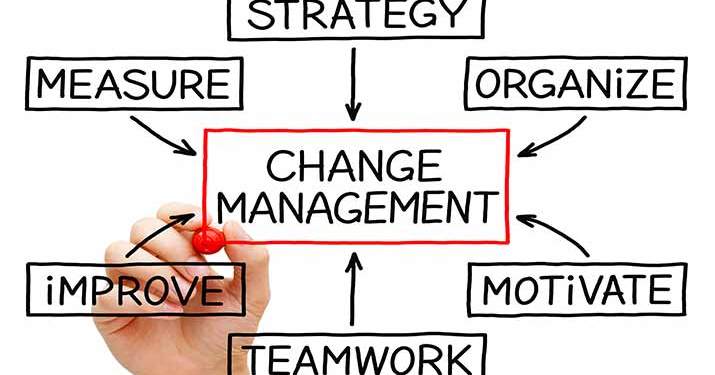What Is Change Management?
Last Updated April 19, 2023

Business organizations today are facing change on a regular basis. As technologies continue to transform entire industries, organizations must modernize and readjust their business outlook, work functions and even their overall goals in response to external market drivers and disruptors.
As organizations realign their labor force to meet new goals, priorities are addressed and reassigned, with some workers taking on new responsibilities. With their employees facing such a variety of change, creating a standardized organization approach to change has become increasingly important for managers wishing to ensure all types of transitions remain as smooth as possible. This is where change management comes into play.
Change Management Defined
What is change management, and why does change need to be managed? Change management is a process of overseeing and facilitating change at any level where it occurs. It is up to management teams to decide exactly how this change will be addressed, develop the process and how to best execute and apply.
The BNET Business Dictionary defines change management as “the coordination of a structured period of transition from situation A to situation B in order to achieve lasting change within an organization.” Similarly, the Change Management Learning Center defines change management as “the process, tools, and techniques to manage the people-side of business change to achieve the required business outcome, and to realize that business change effectively within the social infrastructure of the workplace.”
What are the Benefits of Change Management?
Change management is not a reactive response if change happens; it is preparation for when change happens. Change management allows you to assess your situation and why change is needed, align your efforts and resources, and manage the change itself.
By coordinating and structuring change as a process to be managed, you have a far better chance of seeing results from your efforts. Change management should lead your employees, teams, departments and organization toward thriving and benefiting from change, rather than reacting and merely surviving it—or even worse, seeing no results from the change efforts.
As Dr. Russell Johnson, MSU Foundation Professor of Management in the Eli Broad College of Business, relates, only half of all change management efforts lead to results, explaining that while “very few” had negative effects on an organization, “about half of them had no effect, whereas the other half had positive [but] varied in terms of how positive those changes were. So, although change may not hurt the company, often times, it does not help the company. And that is especially true when changes aren’t rolled out the proper way.”
Basic Principles of Successful Change Management
While the change management process can be different depending on the industry and applied in different ways based on the department versus organizational levels, rolling out change management in a “proper way” tends to follow a few basic principles.
1. Create a Climate for Change
For any organization facing the prospect of change, the first step is to create a climate receptive to change. Change can intimidate, or even frustrate, and it is vital for management to decrease resistance by communicating the importance of the change, guiding the teams where change occurs and providing a clear vision to jump-start the transition process. Communication and transparency on the “why” and “how” behind change are crucial for gaining employee trust and buy-in for change. This helps employees be owners and implementers of the change.
2. Engage and Enable Change
Once the climate is favorable for change, the next step is to engage and enable the organization to enact change. When change is required, it is important to allocate responsibility. Does this change require a specific individual or a team for implementation? Is it an organizational change to be enacted at multiple levels? If so, who will be responsible for coordinating these different levels? Having each of these questions answered can help guide the change process and reduce ambiguities on responsibility. For this reason, it is important to keep communication open, transparent and clear. Also, creating short-term wins can help to keep morale and enthusiasm at high levels.
3. Implement and Sustain Change
With the organization engaged and individuals and teams enabled and motivated, it is time to implement and sustain the change. At this point, it is important to keep focused and maintain the pressure to achieve the desired outcome. While this step may seem rudimentary, it is nonetheless the case that some managers can lose focus and “ease up” during the process. If the target goal shifts during the change process, do not hesitate to adjust accordingly, shifting responsibilities or procedures to keep the drive and focus sustained.
Once the change is implemented and the project has been completed, it is time to solidify the new status-quo and transition the organization from a state of flux to a state of permanence in order to sustain the change.
4. Review and Reflect on Change
With the general principles in place, one final step in the change management process is a review. Despite the best efforts of management personnel to communicate effectively and properly assign responsibilities, change is a dynamic process. After completing a period of transition, it is important to review the aspects of your process that did, or did not, work effectively, then learn from the results.
Reflecting on the outcomes prepares you for next time. When your organization faces change in the future, it can be a benefit to have documented cases of previous procedures that were most beneficial to your organization. With a change management team that has already pinpointed any previous missteps and learned from mistakes, any new changes that arise can be approached with confidence, rather than fear or dread, as positive opportunities for the organization.
Become a transformational leader for your organization with MSU’s online Strategic Leadership & Management Certificates.

